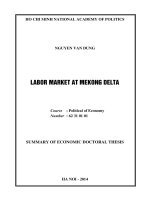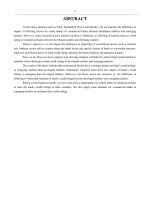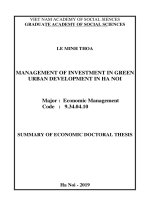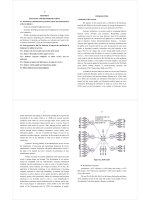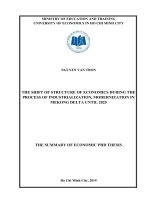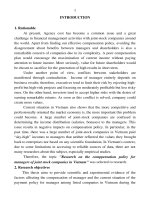Summary of Doctoral thesis of History: The process of economic structural transformation in Bac Giang province from 1997 to 2015
Bạn đang xem bản rút gọn của tài liệu. Xem và tải ngay bản đầy đủ của tài liệu tại đây (190.55 KB, 26 trang )
VIETNAM ACADEMY OF SOCIAL SCIENCES
GRADUATE ACADEMY OF SOCIAL SCIENCES
NGUYEN THI VAN
THE PROCESS OF ECONOMIC STRUCTURAL
TRANSFORMATION IN BAC GIANG
PROVINCE FROM 1997 TO 2015
Major: Vietnamese history
Code: 9 22 90 13
SUMMARY OFDOCTORAL THESIS OF
HISTORY
HA NOI - 2018
Thesis research was done at: Faculty of history - Graduate
Academy of Social Sciences – Vietnam Academy of social
sciences
Supervisor: Assoc.Prof.PhD Vu Quang Hien
Reviewer 1: Assoc.Prof.PhD Hoang Hong
Reviewer 2: Assoc.Prof.PhD Tran Đuc Cuong
Reviewer 3: Assoc.Prof.PhD Nguyen Manh Ha
The dissertation is defended before the DissertationReviewing Board, university-level, at Graduate Academy
of Social Sciences
at ...................................on
(date/month/year)....................................
The dissertation can be found at:
National Library
Library of Graduate Academy of Social Sciences
INTRODUCTION
1. The rationale of the dissertation
Bac Giang is a northern mountainous midland province that was
reestablished in 1997 (separated from Ha Bac province). Implementing
the renovation policy, Bac Giang has mobilized all resources, striving to
accelerate the growth rate and economic structural transformationin the
direction of industrialization, amodernization, sustainable development.
However, due to many difficulties including a lowstarting point with
purely agricultural economy, the industrial and service development in
the province isvery slow, and not corresponding with the potential and
strength of the province.
The survey and field study in Bac Giang showthat the
implementation of economic structural transformationin some areas is
still inadequate, which has not yet generated a rapid pace of economic
restructuring and economic efficiency. This means that the
requirements for economic structural change are very necessary, which
must be in line with the economic development requirements and
aspirations of the people in the province.
The process ofeconomic structural transformationin Bac Giang
province has brought about the problems that need to be analyzed,
answered and clarified on the scientific basis for addressing the issues
of perception and practical activity for business development of the
province today. In that sense, I chose the topic"The process ofeconomic
structural transformation in Bac Giang province from 1997 to 2015" to
sum up this problem from the historical perspective in Bac Giang,
identify the success, together with its characteristics, impacts,
constraints, and causes, so that the study can provide historical data for
1
planning solutions to promote local economic structural change in the
future.
2. Objectives and missions of the dissertation
2.1. Objectives:
- Clarify the process of economic structural transformationin Bac
Giang through various steps from 1997 to 2015;
- Clarify the achievements, limitations and impacts of the process
on the local socio-economic, and security and defense situation;
- Initially draw some historical experience from the process of
implementing the economic structural change of the locality.
2.2. Missions:
- Collect, process and evaluate documents related to the
transformation process of Vietnam in general and Bac Giang province
in particular.
- Analyze the factors affecting the economic structural
transformationin general, and the economic structural change in two
periods: from 1997 to 2005 and from 2006 to 2015.
- Assess the achievements and limitations of the provincial
economic structural transformationprocess; identify the characteristics
and impacts of that process on local socio-economic development.
3. Subjects and scope of the dissertation
3.1. Research objects: The transformation of economic structure
of Bac Giang province in terms of economic structure, economic zones
and economic sectors.
3.2. Research scope
- Regarding time: from 1997 to 2015
- Regarding space: Bac Giang province, including Bac Giang
city, and 9 districts in the province. However, the dissertation also
2
compares the province with the whole country, provinces in the
midland and mountainous areas of the North, and some neighboring
provinces to see the structural transformation of Bac Giang in the
general picture of the regional and the whole country.
- Regarding contents: the research focuses on restructuring of
economic sectors, economic zones and the related issues such as
investment structure, labor structure, etc. in close relationship with each
other.
4. Methodology
4.1. Methodological basis: The dissertation is based on historical
methodology; the methodology of Marxism-Leninism, Ho Chi Minh's
thoughts, views and policies of the Party and the State of Vietnam.
4.2. Research methodology: The dissertation uses the historical
method combined with the logical method. In addition, the dissertation
also uses the methods of analysis, comparison, statistics, field
investigation, etc.
5. Contributions to the science of the dissertation
- Factors influencing economic structural transformation in Bac
Giang province: natural, economic and social conditions; the situation
of economic structural transformationbefore 1997, the views, and
guidelines of the VietnamCommunist Party, the State, and the Party
Committee of Bac Giang province.
- Process of implementing the economic structural
transformationfrom 1997 to 2015, with specific results of each period.
- The achievements, limitations and impacts of the economic
structural transformationprocess in Bac Giang province.
3
- Providethe readers and researchers with the source of objective
and abudent documentations in the field of the process of economic
structural transformation in Bac Giang province from 1997 to 2015.
6. Theoretical and practical meanings of the dissertation
6.1. Theoretical meaning
- To clarify the theoretical issues on Bac Giang's structural
transformation process from 1997 to 2015, i.e., its characteristics and
the meaning of the process. Then, propose solutions to promote the
provincial economic restructuring in the coming years.
6.2. Practical significance
- The research results can be used as reference materials for
provincial departments to write local history; they can be used as
teaching materials, too.
7. Structure of the dissertation
In addition to the Introduction, Conclusion, References and
Annexes, the dissertation is divided into four chapters:
Chapter 1: Overview of literature related to the dissertation
contents
Chapter 2: Economic restructuring in Bac Giang province from
1997 to 2005
Chapter 3: Economic restructuring in Bac Giang province from
2006 to 2015
Chapter 4:Comments and Implications
4
Chapter 1
OVERVIEW OF LITERATURE RELATED TO THE
DISSERTATION CONTENTS
1.1. Overview of research related to thedissertation contents
1.1.1. Research oneconomic structural transformation in
Vietnam
In the whole country as well as in other regions, there are many
works of scientists studying economic structural transformation in
Vietnam from many different angles. Focusing on the main research
missions of the dissertation, the author has studied the economic
structural transformation works in Vietnam in the renovation years,
which not only relates to the dissertation contents but also provides the
author with thinking of research methodology.
1.1.2. Research on economic structural transformation in Bac
Giang Province
During the research, the author also paid attention to and focused
on the published books and works on Bac Giang related to
thedissertation. The research has provided important historical
documents that help the author to reproduce the province's structural
transformation process.
1.2. Overall assessment of the research works related to the
dissertation and further studied issues
1.2.1. Dissertation issues inherited from previous studies
In every aspect of the study, these works provided valuable data
to researchers, which are valuable for the implementation of this
dissertation. These are valuable research results that can be inherited
and developed. However, the research results mainly focus on studying
5
the structural transformation of Vietnam in general and in some key
economic zones with favorable conditions, having a high starting point
when carrying out real implementation. In certain provinces, or in
certain economic-territorial regions in disadvantaged areas where
infrastructure and educational levelare low, there are not many works
mentioned.
By studying and researching the above works, the author gets
some material and knowledge necessary to form a common
understanding, helping the author to deeply study the dissertation. It is
also a source of information to compare and learn the methodology to
approach the problems while presenting the dissertation. Research
oneconomic structural changes in Bac Giang province have good
reference value, providing valuable materials and important suggestions
that help the author in the research process.
In general, the research shows that many works are valuable
materials and have prompted many issues that are charismatic; the
published works are from an economic and historical perspective. The
use of various levels has provided the necessary basis for theoretical
and practical methods to deepen the dissertation research. However, up
to now, the author has not found any works belonging to the
Vietnamese literature coincide with the name of the dissertation. There
are no historical works that have been studied in a complete, systematic
and thorough manner, in terms of economic structural transformation in
Bac Giang province from the re-establishment of the province in 1997
to 2015. Therefore, the author selects this issue in order to ensure both
novelty and scientificity. In the process of research, the author will
inherit the previous research results to approach and complete the
6
project "The process of economic structural transformation in Bac
Giang province from 1997 to 2015".
1.2.2. Dissertation issues that should be studied in depth
Inheritance of the achievements of the previous researchers, and
in comparisonwith the objectives and research missions of the
dissertation, the previous works leave the gap that the dissertation must
continue to solve.
First, systematize the historical process of factors affecting
economic structural changein Bac Giang province from the reestablishment of the province to 2015: on the geographical position and
natural conditions of the province; on the economic situation and
structural economic development of the province at the time of reestablishment of the province; on the policy and guidelines of the Party
in the socio-economic development in general, in the northern midland
and mountainous economic areas, and some specific policies in Bac
Giang; on the leadership of the provincial Party Committee for
economic structural transformation, etc.
Second, clarify the process of economic structural change in Bac
Giang province from the re-establishment of the province from 1997 to
2015, including economic structure, economic zones, and economic
sectors; the characteristics and mainstream circuit of the process; the
appropriateness of the transition and future development orientation.
Third, evaluate the results of the economic structural
transformation process in Bac Giang province (1997 - 2015); The
impact of that process on the socio-economic development of the
province.
7
Chapter 2
ECONOMIC STRUCTURAL TRANSFORMATIONIN BAC
GIANG PROVINCE FROM 1997 TO 2005
2.1. Historical background and factors affecting the economic
restructuring in Bac Giang province
2.1.1. Brief overview of the history when re-establishing Bac
Giang province
After re-establishment, Bac Giang has 10 district-level
administrative units, including Bac Giang town and 09 districts. When
re-established, Bac Giang was still a poor province with a low starting
point and a backward economic structure.
2.1.2. Factors affecting the economic structural transformation
in Bac Giang province
The process of economic structural transformationof the whole
country in general as well as in Bac Giang province in particular are
always affected by the factors of natural conditions; infrastructure and
social conditions; the economic development of the Party in the period
of renovation, and policies of Bac Giang’s Party Division; Situation of
economic structure of Bac Giang province before 1997.
2.2. Economic restructuring
2.2.1. Economic sectors
2.2.1.1. Agriculture, forestry and fisheries
Agriculture, forestry and fisheries marked the most significant
development in the provincial economic development plan. Bac Giang's
agriculture, forestry and fishery sector made a positive but slow move.
2.2.1.2. Industry - construction
The scale of industry - construction was still small, accounting for
the low proportion of GRDP in the whole province with small industrial
8
production, low competitiveness of products, and no spearhead
products.
2.2.1.3. Service
The important task in developing this service was to promote
export, focusing on the development of agro-forestry products and
garments. Other services had increasing investment, innovation in
means of service methods that met the increasing needs of the people.
2.2.2. Economic sectors
2.2.2.1. Government sector
Implementing the guideline to play the leading role of the state
economic sector, the rearrangement of state owned enterprises (SOEs)
was considered as the most important task in the policy of restructuring
the economy of Bac Giang in this period.
2.2.2.2. Collective sector
Most of the cooperatives, especially the cooperativesin the
province, had a stable development stage. However, the operation of
many cooperatives was difficult because the capital contribution of
cooperative members did not meet the needs of production and
business.
2.2.2.3. Private sector
The private sector made good progress, becoming one of the main
economic forces, making an important contribution to the socioeconomic development and structural transformation of the province.
2.2.2.4. Foreign-invested sector
Although the contribution to the province's budget was small, the
foreign-invested sector became an important part of the economy,
positively impacting economic structural transformation towards
industrialization.
9
2.2.3. Economic zones
2.2.3.1. The industrial-service economic zones located on
National Highway 1A
In structural transformation, the province identified industrial
development as a breakthrough sector, which was an active element of
integration with the outside. The development objectives of the area
were to: - Speed up the detailed planning and prepare the necessary
conditions for the early establishment of industrial parks, industrial
clusters, traditional craft villages in locality, contributing to the
economic structural change in the positive direction.
2.2.3.2. Areas of agricultural production
Areas of agricultural production were those with the potential of
expanding fruit tree area, early winter rice area and high value winter
crop such as: peanut, soybean, hybrid corn, fruits and vegetables, etc.
Objectives of the development of agricultural production areas were:
"Planning the production area of clean agricultural products to have
more products for domestic consumption and for exports."
Summary of chapter 2
The process of economic structural transformationin Bac Giang
province is affected by both objective and subjective factors, which
contain advantages and disadvantages, opportunities and challenges. In
the period of 1997 - 2005, Bac Giang province economic restructuring
changed in 3 aspects: economic structure, economic zones, and
economic sectors. The initial results of the structural transformation
process were an important basis for the new development of the
province in the next stage.
Transformation of the economic structure: Agriculture gradually
shifted from traditional agriculture to commodity agriculture. Industry10
construction step by step promoted to increase the proportion in the
economic structure of the province. Service sector gained important
results in rearranging the state-owned trading system, wholesale and
retail market, contributing to stabilizing the market in the province,
boosting the export.
Transformation of the economic zones: the concentrated
commodity agriculture sub-zones were established to exploit the labor
and land strengths of each area in the direction of raising productivity
and product quality. The industrial and service economic zones located
on National Highway 1A initially invested in large industrial zones and
clusters, initially opening up great prospects for attracting investment
capital into the province.
Transformation of economic sectors: There was a positive change
in the implementation of restructuring and reform of SOEs. However,
the state economy did not bring into full play the leading role in the
local economy. For small locally state-owned economy, operating
efficiency was not high. Private sector was encouraged to expand,
focused on developing rural trades, created jobs and improved the lives
of the people. The foreign-invested economy was still small but there
were signs of development with the increasing number of projects
attracting foreign direct investment into the province.
11
Chapter 3
ECONOMIC STUCTURAL TRANSFORMATION IN BAC
GIANG PROVINCE FROM 2006 TO 2015
3.1. New requirements for implementing economic structural
transformation
3.1.1. Historical background that influences the process of
economic structural transformation
Towards the beginning of the 21st century, the province's foreign
investment attraction has seen initial development; however, in the
process of attracting investment, the selection of projects with good
quality and efficiency is a big challenge. In order to be a good
destination for investment, Bac Giang province should accelerate its
competitiveness in the business environment and access high quality
production resources at reasonable prices.
3.1.2. The new requirements that promote economic structural
transformation in the direction of industrialization and modernization
In the early years of the 21st century, provincial economic
restructuring shifted in a positive direction, but the industryconstruction sector was still at a low development level. Therefore,
economic structural change was indispensable to further develop the
economy of the province.
3.2. Economic restructuring
3.2.1. Economic structure
3.2.1.1. Agriculture - forestry - fishery
The striking result of the economic structural change in
agriculture was the simultaneous increase of the share of the forestry
and fishery sector and the decline in the share of the agricultural sector.
12
However, the rate of change was still slow;the share of agriculture,
forestry and fishery in FPD remained high compared to the whole
country’s rate.
3.2.1.2. Industry - construction
Industry in Bac Giang in this period was considered as a
spearhead economic sector with a fast and stable economic growth rate.
The ongoing industrial restructuring has contributed significantly to the
growth and economic development of the locality in particular and the
country in general.
3.2.1.3. Service
In the period of 2006 - 2015, the diversified service sector
attracted many economic sectors to meet the increasing requirements of
socio-economic development.
3.2.2. Economic sectors
3.2.2.1. Government sector
In general, the process of restructuring, reforming and enhancing
SOEs' effectiveness removed most of the enterprises operating
ineffectively, causing prolonged losses. The process also increased
investment in technological innovation and increased labor
productivity, promoting provincial economic structural change.
However, the equitization of SOEs was still slow and not highly
effective.
3.2.2.2. Collective sector
The collective economy achieved good results in the process of
production development, renewing the face of the countryside. Many
cooperatives developed quite stably, contributing significantly to the
socio-economic development and the structural transformation of Bac
Giang province.
13
3.2.2.3. Private sector
Private sector had a strong development and significant
contribution to growth and structural transformation of the province at
this stage. Contribution to revenue collection from enterprises and
individuals producing and trading goods and services increased rapidly,
accounting for 6.11% of total state budget revenues in the area.
3.2.2.4. Foreign-invested sector
In the period of 2006 - 2015, Bac Giang attracted 198 foreign
direct investment projects, with a total registered capital of $2,341.75
million, which was 19.8 times in terms of the number of projects and
88, 8 times in terms of registered capital higherthan 1997-2005 period.
3.2.3. Economic zones
3.2.3.1. Industrial Economic zones - Services along the National
Highway 1A and Bac Giang City
The development of industrial zones and clusters brought new
vitality to the economy, promoting the economic structural change of
the province in a positive way. The development of industrial zones and
clusters also formed industrial plant material areas such as peanut and
soybean; fruit trees such as litchi, etc. associated with the processing
industry.
3.2.3.2. Area of agricultural production
A number of large-scale commodity agricultural production areas
were established. These products have recently been characterized such
as Luc Ngan litchi, Yen Dung rice, Tan Yen peanut, Lang Giang
mushroom, Dien Luc orange and grapefruit, Luc Nam pineapple, Yen
The hen, etc.
14
Summary of chapter 3
Based on the results of economic structural transformationin the
years 1997 - 2005, in the period of 2006-2015, Bac Giang continued to
have new guidelines and policies to promote the potential and
advantages of the province to foster the socio-economic development of
the locality. The effects of implementing the economic structural
changewere clearer in the modern direction, reflected in the fields of
economic structure, economic sectors and economic zones.
Transformation of the economic structure: a shift in the right and
reasonable direction. However, the restructuring of the sector did not go
into the depth of social labor division, based on exploiting the
comparative advantage of the locality.
Transformation of economic sectors: Continued the path for
SOEs arrangement and management; continued to renovate the
cooperative management mechanism under the Cooperative Law.
Private sector developed. The foreign-invested sector grew and
increased its contribution to the economy.
Transformation of economic zones: There were relatively stable
developments in both agricultural production and service-economic
zones.
15
Chapter 4
COMMENTS AND IMPLICATIONS
4.1. Comments on the economic structural transformation of
Bac Giang province
4.1.1. Some achievements and limitations of the economic
structural transformationprocess of the province
The process of economic structural change in Bac Giang province
in the years 1997 - 2015 achieved important results. Firstly, Bac
Giang's economic restructuring took place in a positive trend. Secondly,
the economic structural change in Bac Giang formed the specialized
production areas, of which wasthe largest fabric production area in the
country. Thirdly, the economic structural change of the province
promoted the potential of economic sectors, creating more and more
suitable production relations. Fourthly, the economic structural change
in Bac Giang was linked to the process of industrialization and
modernization of agriculture and rural areas, gradually bringing about
prosperity for the rural economy of the province.
Beside achievements, the process of economic structural
transformation in Bac Giang had some limitations. Firstly, the
deployment of economic structural change activities at some time was
still confusing and not really flexible; the management and planning
were not really scientific, leading to many adjustments and
modifications. Secondly, the process of shifting economic structure
followed a positive trend but not sustainably.
4.1.2. Impacts of economic structural transformation in Bac
Giang province
16
The process of economic structural transformation in Bac Giang
had impacts on economic growth and development, socio-culture,
defense and security of the province.
4.2. Experiences and problems
4.2.1. Some experience
Firstly, the process of leading and directing the activities of
economic structural transformation must be based on local realities,
with appropriate policies and measures to effectively implement
economic structural change; Secondly, in the process of implementing
economic structural transformation, it is necessary to integrate
production development, step by step making the relations of
production more progressive; Thirdly, to develop all resources in the
community must be based on the people to carry out effective economic
structural transformation; Fourthly, care must be taken to build up the
Party, consolidate the government, build up the contingent of cadres
who can meet all requirements and tasks of the locality.
4.2.2. The problems
Bac Giang province's economic restructuring process in the years
1997 - 2015 still has some problems, and there is a need to take
measures to overcome them. First of all, the problem of human
resource developmentstill faces many difficulties which have great
impacts on the process of structural transformation of the province.
Secondly, the issue of environmental security, despite being considered
in the process of implementing economic structural change, remains a
risk. Thirdly, the tendency of the state economic sector in Bac Giang
has not shown the leading role in the economy of the province.
17
Summary of chapter 4
The process of economic structural transformation in Bac Giang
in the years 1997 - 2015 has achieved important achievements, but there
are also some limitations that have great impacts on economic growth
and development; on culture and society; on national defense and
security. These impacts contribute to the overall development of Bac
Giang on the path of integration and implementation of industrialization
and modernization. Therefore, the synthesis of local experiences in
implementing economic structural transformation is a necessary
requirement. The transformation process of Bac Giang province in the
years 1997 - 2015 has created a change in the "quality" of the economy,
making the people's life significantly improved. However, in the
process of carrying out the activities of economic structural
transformation in the locality, there are still some problems to be
solved, such as: human resource development, environmental security
and the tendency that the state economic sector in Bac Giang has not
shown the leading role in the economy of the province.
18
CONCLUSIONS
1. The process of economic structural transformationof Bac Giang
province from 1997 to 2005 took place in all aspects. From an
economic point of view, it has become a province with a high
proportion of industry and services, accounting for 76.4%, and
agriculture - forestry - fishery is only 23.6%. The economic growth rate
of the province has been relatively high in comparison with the whole
country, about 9% per year in recent years. Under the conditions of
transition mechanism when the serious consequences of the previous
periodneeded to be overcome, and the traditional markets from the
former Soviet Union and Eastern Europe were suddenly shrinking, the
province has achieved such growth that plays a very important and
significant role in the overall development of the whole province. By
2015, the per capita income reached VND 31.08 million, higher than
the average level of midland and mountainous provinces in the North
(VND 19.36 million in 2014). The poverty rate decreased considerably
from 15.32% in 1997 to 7.9% in 2015, equivalent to the national
average of 7% in 2015, and much lower than the average of Northern
Midlands and Mountains (16% by 2015).
2. Transformation of economic structure in three aspects:
economic structure, economic sectors, and economic zones. Economic
restructuring has been carried out in the direction of increasing the
proportion of industry and services, reducing the proportion of
agriculture, forestry and fishery while maintaining the growth rate of all
economic sectors. The structural shift is due to the high growth of the
industry and the services sector over the agriculture and forestry sector.
This is a shift in the right direction and in accordance with the
19
requirements to accelerate the economic growth and the process of
industrialization and modernization of the province.
The development of economic sectorsbased on the diversification
of ownership forms is a great policy of economic reform in general and
economic structure reform in particular. The most important measure in
the years 1997 - 2015 in Bac Giang was to organize and rearrange stateowned enterprises. After nearly 20 years of reorganization and
restructuring, the number of state-owned enterprises reduced to only
36% of the time of re-establishment (down from 72 in 1997 to 26 in
2015). The business efficiency of some enterprises after reorganization
has raised. However, not all state-owned enterprises, after reorganizing
and rearranging, have achieved efficiency in production and business,
especially some small and medium-sized enterprises which have
suffered from waxing lossesand needed to merge, dissolve, or cease
operation, etc. This fact requires that the implementation of business
reorganization must be continued and improved.
The results of structural transformation have concentrated on the
transformation of the economic sector in a positive direction, consistent
with the process of promoting industrialization and modernization. This
shift has contributed to the formation of a dynamic economic zones in
large industrialized areas, industrial clusters and agro-industrial zones.
These include the largest concentrated fruit growing areas in the
Northern provinces, the largest litchi production area in the country,
Yen Dung fragrant rice production area, the vegetable processing and
export area in Bac Giang city, the formation of farms of high ranking in
the country,and industrial zones and clusters of Bac Giang city.
Particularly, this transformation has created favorable conditions for the
private economic sector and foreign-invested economy to develop
20
strongly in the province and become an important driving force for Bac
Giang's fast and sustainable economic development.
3. In addition to the successes, in the process of structural
transformation of Bac Giang province from 1997 to 2015, there are
some shortcomings: In general, beside the achievements, the provincial
socio-economic development has changed slowly, unstably and not in
line with the requirements set for some fields. The economy is still
heavy on traditional activities that bring low value, but light on new
activities that bring high value to push for economic development
breakthrough. Moreover, the broad-based growth model in the early
stages of development is suitable to the conditions of the agricultural
province which is located in the Northern Midlands and Mountains and
has low average incomes; however, a growing economy based mainly
on capital and labor will not ensure sustainable development in the
future. This is a great challenge for the process of implementing
economic structural change towards industrialization and modernization
ofBac Giang. In order to get out of this situation, the province needs to
strengthen both the pull and push forces of the economy, in which
standardization of product quality, trade promotion, and market search
for key products must be top priorities.
On the other hand, the implementation of economic structural
change activities at some time is still confusing and not really flexible;
the management and planning are not scientific, which leads to many
adjustments and modifications affecting the general planning strategy of
the province.
4. Advantages and limitations, successes and failures of the
process of economic structural change of the province have great
significance for the socio-economic development and security of the
21
locality. The success of Bac Giang during the implementation of
structural transformation activities has shown the capability of timely
grasping the opportunities, and advantages; as well as overcoming the
difficulties and challenges to bring great successes to the restructuring
of the province's economy to have great impacts on the political,
economic, cultural, and social development, and security of the locality.
The practice of economic structural change in Bac Giang province also
poses a number of issues that need to be further researched and solved,
especially the development of high quality human resources in the
future, environmental security issues in the process of implementing
economic structural change and economic development; the tendency of
the SOE sector to improve the performance of SOEs must be of primary
concern.
Although there are some limitations in the implementation
process, it can be said that the success of the process of implementing
the economic structural change of Bac Giang province from 1997 to
2015 is fundamental. This success is created by the creativity and
efforts of the whole political system in which the leadership of the
Communist Party and the participation of governments at all levels play
a decisive role. The collectiveand close cooperation with high
responsibilityof the people are of great significance. In each period
during 20 years of re-establishment, after overcoming difficulties and
challenges, Bac Giang achieved great socio-economic achievements,
marking the progressivedevelopment of the province, and contributing
positively to the development of the country.
Each period is passing through with the valuable lessons to help
Bac Giang firmly step up the next step. Promoting the resilient
revolutionary tradition, the glorious historical tradition of the homeland,
22
the abundant labor and land resources, the dynamic spirit of creativity,
solidarity in the construction and defense of the country will create the
power to help the Party, government and people of Bac Giang province
develop the socio-economy fast and sustainable, together with the
whole country striving for the goal of "prosperous people, strong
country and democratic, fair and civilized society."
23
